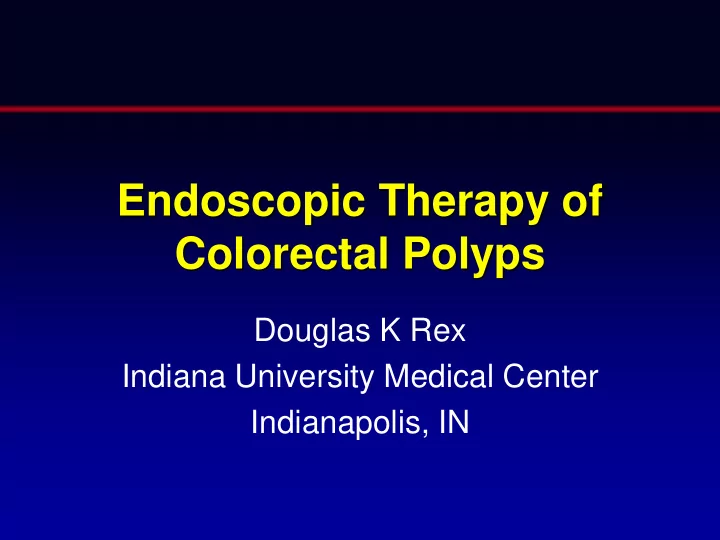

Endoscopic Therapy of Colorectal Polyps Douglas K Rex Indiana University Medical Center Indianapolis, IN
Topics listed in the brochure Realistic miss rate of significant polyps during colonoscopy Is withdrawal time a realistic quality indicator? Is repeat colonoscopy ever justified for missed polyps? Does the data showing the reduction of colon cancer by screening colonoscopy factor in missed polyps and flat lesions? What to do with diminutive polyps? Not covered: Endoscopic therapy of colorectal polyps (but we can discuss it in the Q and A)
Realistic miss rate for “significant polyps” Rex tandem colonoscopy study: 6% (2/32) for adenomas ≥ 10 mm CTC studies – Pickhardt: 12% – Van Gelder: 17% In clinical practice you can’t measure the miss rate: you can only infer it from what is detected (the adenoma detection rate) – Barclay (Rockford) and Chen (Indiana): a group of endoscopists misses more than half of the large adenomas
Why don’t we measure large adenoma detection rates? Harder to specify the expected range and acceptable thresholds Subject to operator error in measuring polyp size Have to examine 5-10 times as many records In both the Rockford and Indiana studies large adenoma detection correlated with overall adenoma detection
Is withdrawal time a realistic quality indicator? Primary measure of the quality of mucosal inspection is the ADR Withdrawal time is a secondary indicator; it does not explain all variation in ADR – Consistent statistical correlation across studies – Increasing WT increased ADR in the Rockford study (not in a study from Boston)
Withdrawal time as a quality indicator Easy to measure (record cecal intubation times – WT counted only if no polypectomy or biopsies performed) Emerging as a standard of care issue despite warnings of USMSTF and ASGE/ACG Should be measure in all patients Should be first focus if the ADR is low
Does the reduction of colon cancer by screening colonoscopy factor in missed polyps and flat lesion? Which data are you speaking of? – No RCT of screening colonoscopy – 1 cohort study of screening colonoscopy (Kahi et al CGH 2009) – Multiple adenoma cohorts: NPS, U.S. dietary trials, U.S. chemoprevention trials, Funen adenoma study – Case control studies: Brenner, Muller – Sonnenberg, Singh, Baxter
Does the reduction of colon cancer by colonoscopy factor in missed polyps and flat adenomas? Of the various causes of interval cancers, quantitative assignment of the causes is not currently possible
Why do interval cancers occur?
What to do with diminutive polyps? Current policy: resect all except ok to sample multiple diminutive rectosigmoid polyps that look hyperplastic Future policies: – Leave diminutive HP polyps in the distal colon in place; use photo as documentation of histology – “Resect and discard” diminutive polyps
Accurate real time histology techniques Narrow band imaging with and without HM FICE I Scan Confocal laser microscopy Endocytoscopy Chromoendoscopy with high magnification
Recommend
More recommend